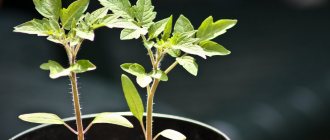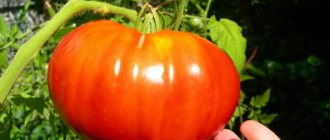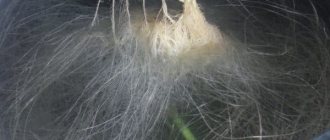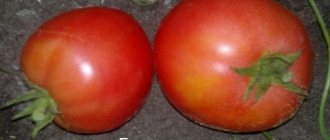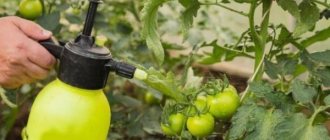Description of the variety
The main distinguishing features are:
- average bush height: as a rule, does not exceed 1 meter;
- short ripening time: no more than 90 days;
- determinacy;
- relatively average foliage;
- light green leaves;
- leaf shape - characteristic of nightshades;
- a simple raceme and a simple inflorescence;
- there are no more than 6 fruits in the ovary;
- round shape of the fruit;
- high density of tomatoes;
- gloss and smoothness of the surface;
- the weight of the tomato does not exceed 120 grams.
Description and characteristics of the variety
Bulat f1 is a determinate hybrid with very early ripening. Tomatoes turn red already 80 days after germination.
Bushes up to 75-85 cm high, strong and powerful, produce up to 8-9 fruiting clusters. Up to 6 fruits ripen on each branch, the average weight of tomatoes is 100-120 g. The weight of the largest is 250 g.
Tomatoes are distinguished by their elasticity, durable skin, and extraordinary taste. The pulp at the break is juicy, the number of seed chambers is 5-6.
Seedling method:
In the central part of the country, seedlings can be grown in early to mid-March. And in open ground - in early May.
It is used most often, suitable for greenhouses and open ground. Before you begin preparing seeds for planting, you must:
- pour the seeds into a glass;
- fill it with water;
- add a teaspoon of salt;
- mix;
- after 20 minutes, all unusable material will float to the surface and will need to be disposed of.
Next steps are your choice. If you want to speed up the emergence of seedlings, then soak the seeds in a growth activator for a few minutes or place them in damp gauze for several days.
IMPORTANT! Humidity will require constant monitoring on your part, since if it dries out, the seeds will die. As soon as the green seeds hatch, immediately begin transplanting them into containers.
If you are not in a hurry, you can immediately start planting in pots.
It is better to choose pots either peat or humus-earth bags. Such devices will not only act as fertilizer, but will also not damage the roots when transplanted into the ground. After all, they are placed in the ground together with the seedlings, and then completely dissolve without causing harm to the plant.
When planting, bury the seeds. The depth is no more than 1 cm, and between the grooves (mini-holes) - no more than 2 cm.
To create greenhouse conditions, cover the pots with film.
INTERESTING! Ready-made greenhouses are becoming increasingly popular, which will not only easily fit on the windowsill, but will also simplify the process of germination of tomatoes.
Continue to monitor soil moisture. If necessary, water, but very carefully: do not let the seeds float due to the abundance of water.
As soon as the first leaf appears on the surface, remove the film, otherwise the seedlings may burn.
Remember about daylight hours! For seedlings it must be at least 14 hours. If there is not enough natural light, use a phytolamp. It can be purchased at any gardening store. Install at a distance of no more than 15 cm.
Has 4 leaves appeared? Start picking the seedlings and divide them into different pots. How to do it right? In order for the seedlings not to lose growth, but to strengthen in the root system, immerse the sprout in the ground until the first leaves. The distance between them and the soil in the pot should be no more than 1 cm. After a few days, you will be able to notice a clear strengthening of the leaves and the active formation of new ones.
- the room temperature should not fall below +25 degrees;
- the soil should not dry out or be excessively waterlogged;
- Harden the seedlings by ventilating them or taking them outside.
14-17 days after picking, fertilize all seedlings, for example, with nitroammophos. To do this, dissolve half a spoon of fertilizer in five liters of water. For one seedling no more than 100 ml. After 14 days, repeat the procedure.
INTERESTING! If the leaves begin to curl and wrinkle, this directly indicates a lack of potassium. Fertilize the plants well and within a few days you will notice improvements.
Growing and care
Fit selection
The Bulat tomato variety is intended for cultivation throughout Russia, but the timing and method of planting differ significantly from each other. For example, in the south of the country, a seedless method of growing tomatoes is possible, but in more northern cities you should not expect a good harvest without growing seedlings. As for the time of planting seeds in open ground and for seedlings, everything is individual, so let's dwell on this point and consider all the possible options.
Seedling method
In the southern regions, seedlings begin to be grown in the third decade of February. So that in mid-April, when the ground reaches the desired temperature, the seedlings are ready for transplanting. In the central part of Russia, gardeners begin sowing seeds on March 15, and plant plants in open ground in the first half of May. The northern regions sow seeds for seedlings in the first ten days of April, and by the end of May the seedlings decorate the garden.
Seedless method
The approximate date for sowing seeds in open ground will depend on weather conditions and the heating temperature of the top layer of soil. It is advisable to wait until the ground warms up to 12 degrees and only then start planting seeds. Before sowing, it is important to check the weather forecast and if night frosts are not expected in the next two weeks, then feel free to plant tomatoes.
Soil preparation
In both cases of growing tomatoes, you first need to prepare the soil. At the beginning of autumn, it is necessary to decide on a planting site without disrupting crop rotation. Next, the selected area is dug up with nutritious fertilizers, which can be humus or ash. After winter, the plot needs to be dug up again, only this time you should not apply various fertilizers, because soon after planting the tomatoes, you will make the first fertilizing.
Seed preparation
Before planting, seeds need to undergo a series of procedures that activate their growth. First of all, it is important to separate empty seeds from full ones. To do this, the planting material is filled with water for two hours, then they look at the result; the seed that floats to the surface will not sprout because it is hollow, therefore, it can be immediately thrown away. And the seeds that have settled to the bottom are transferred to gauze, which has been previously moistened with water and left in the “clothing” for a day. After this, the seeds are dipped in a weak solution of potassium permanganate and treated with a growth accelerator. Further actions depend on the choice of landing.
How to plant seeds in open ground
It is possible to sow Bulat tomatoes in open ground only in the south of the country, since it is there that the climatic conditions are ideal for cultivating tomatoes without seedlings. To do this, you need to water the bed under the tomatoes with settled water, make small depressions in the bed, put a treated seed in each hole, cover it with soil, water it again and cover it with a film cover, creating a greenhouse effect. After the first leaves appear, the film will no longer be needed, so it can be removed. And the sprouts undergo standard care, which we will talk about a little later.
Seedling method
Every gardener can plant and grow good seedlings. Of course, this will take a lot of time, but if you want to enjoy a Bulat tomato while living in the northern or central part of Russia, then without first growing seedlings you will not succeed.
So, first of all, you need to collect soil from the garden and bring it into the house a week before the expected date of planting the seeds, so that the soil has time to “warm up”. A couple of days before the appointed date, calcine the earth in the oven at a temperature of 40 degrees. Place the soil for the seeds in boxes or other convenient containers. Process the seeds. Water the soil, make grooves 1 cm deep in it and plant the seeds at a distance of 2 cm from each other. Cover the container with film or glass. Leave the vessel in a room where the air temperature is 22-25 degrees.
In a few days, green leaves will appear on the surface of the earth. Remove the film or glass and water the plants with water at room temperature. Make a pick. If the tomatoes appear weak, then it is necessary to introduce fertilizer for seedlings, which will help strengthen the seedlings and improve growth. Two weeks before transplanting the sprouts into the garden, the plant needs to be hardened off. To do this, first gradually reduce the temperature in the room to 15-17 degrees, then move the seedlings outside for 5 minutes, and with each “walk”, double the time.
Attention! Picking of seedlings occurs at the moment when 4 true leaves appear on the sprouts.
On the day of transplanting tomatoes, the bed must be watered generously, holes must be made at a distance of 30 cm from each other, leaving a gap of half a meter between the rows. Place a seedling in each hole and cover it with soil so that the two lower leaves are a millimeter above the soil layer. After planting the plants, water each future bush again with water. Next, the plant will only need basic care.
Tomato care
The main care of plants consists of weekly watering, after which it is necessary to immediately loosen the soil so as not to disturb air exchange. In addition, removing weeds from the beds is also an integral part of courtship. Fertilizing plants three times a day during the growing season can improve the growth of bushes and increase productivity. Each feeding has its own stages:
- The first feeding is carried out 14-16 days after planting the seedlings. Fresh chicken droppings contain a lot of nitrogen and phosphorus, so this fertilizer will have a beneficial effect on the growth of seedlings. To produce the first feeding, you must first prepare a solution. To do this, dilute 1/3 of a bucket filled with chicken manure with 7 liters of water, leave the liquid for a week. Then dilute half a liter of liquid with a bucket of water (10 l) and water the bushes. One bucket of diluted solution is enough for 2 square meters. m.
Attention! Feeding from chicken manure is done strictly at the root or watered between the rows.
- It is recommended to carry out a second feeding during the flowering period. We recommend using complex fertilizer. It is rich in minerals, which the plant so needs during the flowering period. For this tomato variety, you can use a mixture of 5 g of potassium grain acid and 50 g of nitroammophoska. Bulk ingredients must be poured into 10 liters of water, stirred until the crystals dissolve and poured under the bush. Water consumption per plant should not be more than a liter.
- During the fruiting period, the last feeding is done. It is needed so that the fruits on the plant ripen faster and increase in volume. Regular iodine can cope with this task. Dissolve 4 drops of an alcohol solution of iodine in a bucket of water (10 l) and water the bushes. One bucket is enough to water 5 plants. It is important to water the tomatoes under the bush to avoid injury to the leaves and fruits.
A good harvest directly depends on the quality of the seeds and care of the plant during the growing season. Therefore, when choosing planting material, give preference only to trusted manufacturers. And remember that seeds from varieties of hybrid origin are not left for next year, since this species is not intended for further cultivation, unlike conventional tomato varieties.
Growing
Bulat tomato can be replanted in open ground after 50-60 days. Pre-enrich the soil with useful substances. and water the seedlings in pots generously on the day of transplantation.
Classic landing pattern:
- the distance between the holes is no more than 30 cm;
- the distance between rows is no more than 50 cm.
Immerse the sprout in the ground so that the distance between its lower leaves and the ground does not exceed 0.5 cm. Afterwards, water it generously.
Planting Bulat tomatoes
In order to obtain a higher yield, experts recommend planting eggs in seedlings. To plant seeds, you need to prepare special boxes and soil. The soil needs to be mixed with fertilizers; humus or salicor are perfect for this. The boxes need to be filled with soil and moistened. Seeds are planted at a depth of no more than one centimeter. The boxes are covered with film on top and put away in a warm area with access to sunlight. Every day, water the soil in the boxes with warm water. This will help seedlings emerge faster.
Seedless method
It is considered the most risky, since the number of seedlings may be reduced due to insufficient readiness of the seeds and difficulties encountered during planting. But for Bulat tomatoes it is often used, mainly in regions with a southern climate, since the soil warms up faster and deeper.
In order to be sure that the land is ready for planting, it is necessary to measure the average daily temperature for a week, and the soil temperature should not fall below +12 degrees.
It is better to nourish the soil for the seedless method in the fall. This way the nutrients will best penetrate into the deep layers and it will be easier for the seeds to germinate.
It is better to select seeds before planting. For empty detections:
- pour water into a glass;
- add salt;
- stir;
- leave for 20 minutes;
- After the time has passed, all those that have floated can be thrown away: they are empty and will not be able to germinate.
Next, the seeds must be placed in damp gauze for a day and soaked in a growth accelerator.
Seed preparation
Seeds should be purchased from specialized retail outlets. Before planting, you need to remove empty seeds. To do this, they are filled with water for 2 hours; if there is no seed inside the shell, then it floats to the top. Such seeds should be collected from the surface of the water and discarded. The seeds that remain at the bottom should be transferred to damp gauze and left for a day, constantly maintaining humidity.
After the allotted time has passed, the seeds are soaked in a weak solution of potassium permanganate. This will help avoid infection by fungi and various viruses. For faster development, you can treat the seeds with a special growth accelerator.
tomato Bonaparte F1 - description and characteristics of the variety
Planting and growing
The next day after soaking, it is necessary to prepare the wells. Planting pattern:
- the distance between the holes is no more than 30 cm;
- the distance between rows is no more than 50 cm.
Before planting, be sure to water the bed with settling water. In each hole - one seed. Sprinkle with soil and water again. IMPORTANT! Cover each hole with planting film - this will help create greenhouse conditions and speed up seed germination. As soon as the first leaves appear, immediately remove the film. Otherwise, the plant will die.
Bulat tomato care
The same for both seedling and non-seedling growing methods.
Watering
Water tomato bushes strictly - once a week. Under no circumstances should the water be cool. Water strictly to the roots. Contact with water can lead to the development of fungal diseases.
Loosening
It is advisable to loosen and hill up after each watering. This will not only help enrich the root system and make it stronger, but will also prevent weed germination.
Weed grass
There is an opinion that weeds should not be removed under tomato bushes. Supposedly this will protect against sunburn and disease. This is fiction. Bushes should be cleared of weeds: they only hinder normal development, and pests feel right at home there. They also cause a lot of inconvenience when treating diseases, and harvesting is delayed.
Ventilation
If you decide to plant your tomato in a greenhouse, then do not forget to ventilate it once a day and be sure to monitor the temperature inside. High humidity and temperature can lead to the development of fungal diseases and the death of all seedlings.
It is very important to feed Bulat tomato in a timely manner. This must be done in three stages:
Stage No. 1
Weeks after planting in open ground (for the seedling method), for the seedless method, it is worth focusing on the first leaves: as soon as they have formed, you can feed them. Give preference to complex fertilizers, such as nitroammophoska. Stage No. 2
Feeding during the flowering period helps to gain strength for fruit formation. Here you need to give preference to fertilizer with a high potassium content. But you can still use fertilizer for the first stage.
Stage No. 3
The latter is carried out during the formation of tomatoes. Here, again, you can fertilize with nitroammophos or dilute a few drops of iodine in a bucket of water and stir well. One bucket is enough for 4 bushes.
When watering, be careful and try not to injure the bushes.
Resistance to diseases and adverse conditions
The variety has stable immunity and practically does not get sick during the ripening process.
But if mistakes were made by the gardener (overwatering, high humidity), this can lead to the development of:
- late blight
How to identify? A white coating appears on the back of the leaf. The leaves begin to curl and become covered with brown spots. Tomatoes also become covered with brown spots. externally resembling putrefactive ones.
How to fight? If the bush is sick, no chemicals or folk remedies can help. It must be removed from the site, and the ground must be cultivated and dug up. It is advisable to replace it with a new layer, at least in the area of the infected hole. It is also prohibited to use it as tops.
Prevention: ventilation of the greenhouse. timely watering, treatment with chemicals.
ATTENTION! Only until the flowers form.
- spider mite
How to identify? The appearance of cobwebs on the bushes, which literally covers the entire bush. It is easiest to detect during the daytime with high solar activity. Tomatoes outwardly resemble fruits that are not at all juicy, as if someone had siphoned the juice out of them.
Where to hide? On the underside of a leaf, under fallen leaves or lumps of earth under a bush.
How to fight? Long and persistent, so tick eggs, even after treatment, can be stored for more than 5 years. One of the easy ways. Water the bush generously from crown to root with water and cover tightly with a bag. the plant will not be damaged, but the mite will die from the increased humidity. Spraying with sulfur and phosphorus preparations is suitable
- mole crickets
How to identify? Pay attention to the appearance of the bush - it is tilted, outwardly very weak and as if withered. Individuals (no more than 10 cm, brown with powerful legs) and larvae (brownish in color, resemble worms) are dangerous and together eat up the roots.
How to fight? Do not feed the soil with mullein. Plant marigolds around the perimeter of the bed - they are unpleasant to mole crickets. Loosen the soil as often as possible. And also use chemicals, but only before the flowers appear. If you choose granular products, be sure to bury them in the ground. This way the bears can get to them faster and die.



